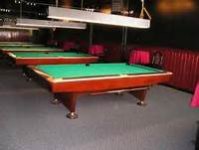This whole "tight pocket" debate has been done many times allready on this forum. I think the issue is less simple than some make it appear. Obviously, on perfectly maintained tournament tables with brand new cloths and professionals playing on them, tight pockets are ok. Those tables get serviced by the best and always have new cloths on them, helping the balls drop.
On the other hand, most of us play in pool halls, whose economic situations do not seem to get better as time goes by..If the pockets are done even slightly bad, or the facing gets hammered by constant play, then the pockets will no longer play right, and that is the situation that 95% of us will be facing. Not just us purists, but casual and low level players will be constantly annoyed by rattling balls, taking every bit of fun out of the game.
Regarding the OP's diagrammed shot, not all GCs with tight pockets are alike, as some seem to suggest. The angle of the facings, the material used in the facing, the thickness of the facing, the wear and tear on it, shelf depths etc...All of these things will matter, with the added normal factors like humidity, cloth wear etc...No firm statement can be made on a matter like this. All I can say is: If your game is 14.1 and you want advice on pocket size, I would strongly advice against anything smaller than professionally done 4.5 inch pockets (and recommend 4.75), and if your mechanic is not top notch I would extend that recommendation to all games (except maybe one pocket). I'm so sick and tired of tables with "trouble pockets" that must be avoided etc..Some of you will know what I'm talking about.
I've played on lots of different snooker tables, and I can honestly say I've never felt robbed by a pocket, like I have countless times on the pool table. Pool pockets are difficult to get right and unless you are on a factory fresh diamond 4.5 inch pocket, there will be some issue with nearly every table built, even GC's with buckets will sometimes act up.
On the other hand, most of us play in pool halls, whose economic situations do not seem to get better as time goes by..If the pockets are done even slightly bad, or the facing gets hammered by constant play, then the pockets will no longer play right, and that is the situation that 95% of us will be facing. Not just us purists, but casual and low level players will be constantly annoyed by rattling balls, taking every bit of fun out of the game.
Regarding the OP's diagrammed shot, not all GCs with tight pockets are alike, as some seem to suggest. The angle of the facings, the material used in the facing, the thickness of the facing, the wear and tear on it, shelf depths etc...All of these things will matter, with the added normal factors like humidity, cloth wear etc...No firm statement can be made on a matter like this. All I can say is: If your game is 14.1 and you want advice on pocket size, I would strongly advice against anything smaller than professionally done 4.5 inch pockets (and recommend 4.75), and if your mechanic is not top notch I would extend that recommendation to all games (except maybe one pocket). I'm so sick and tired of tables with "trouble pockets" that must be avoided etc..Some of you will know what I'm talking about.
I've played on lots of different snooker tables, and I can honestly say I've never felt robbed by a pocket, like I have countless times on the pool table. Pool pockets are difficult to get right and unless you are on a factory fresh diamond 4.5 inch pocket, there will be some issue with nearly every table built, even GC's with buckets will sometimes act up.


